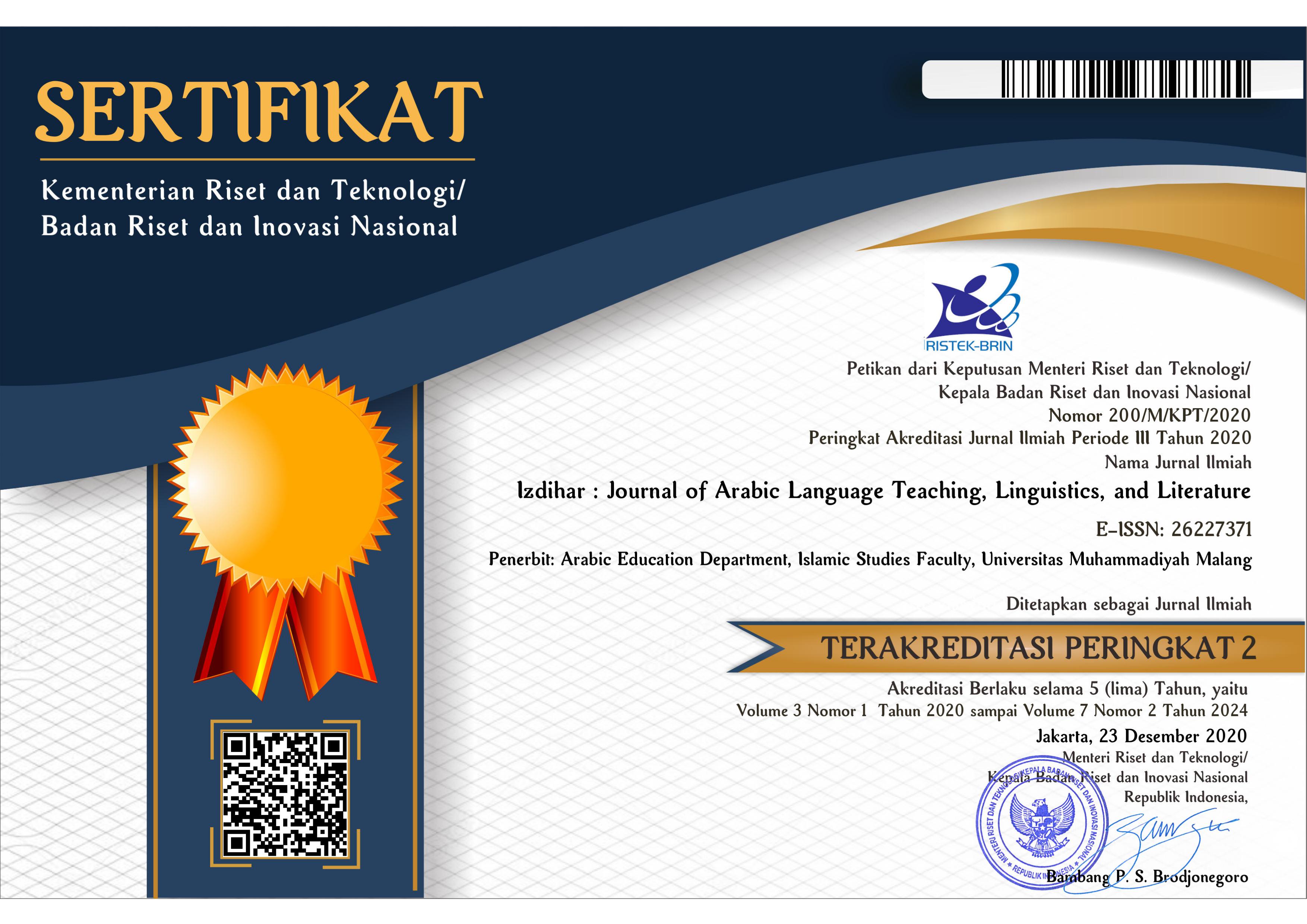The Role of Language Acquisition Theory in Arabic Online Learning (Skinner’s Behaviorism Perspective)
DOI:
https://doi.org/10.22219/jiz.v5i1.19648Keywords:
Arabic Online Learning; BF. Skinner; Language Acquisition TheoryAbstract
This article aimed to find out what the role of behaviorist language acquisition theory in learning Arabic online from the perspective of BF. Skinner. This research was a literature review that explores information about the role of language acquisition theory in learning Arabic, especially the idea of behaviorism according to BF Skinner's view. This research showed that the theory of BF Skinner's language acquisition plays a role in learning Arabic because it can help teachers determine what kind of technology media and methods will be used by teachers in learning Arabic. In selecting technology media and learning methods, Arabic teachers should use Synchronous Learning-based media and techniques as much as possible. Synchronous Learning is online learning with direct communication, such as using the Zoom cloud meeting application. Because the purpose of learning Arabic can be achieved if there is habituation in the four language skills, the teachers can also determine the reward or reinforcement for Arabic language learners according to the learners' psychological condition so that learners will be encouraged to improve their language skills even in online learning conditions continuously.
Downloads
References
Abdul Chaer. (2009). Psikolinguistik Kajian Teoritik (II). Rineka Cipta.
Arifin, Z., Febriani, S. R., Saputra, H. Y., & Anasruddin, A. (2021). Arabic learning in the digital era: Approach in online system. Lughawiyah: Journal of Arabic Education and Linguistics, 3(1), 73. https://doi.org/10.31958/lughawiyah.v3i1.2752
Coman, C., Țîru, L. G., Meseșan-Schmitz, L., Stanciu, C., & Bularca, M. C. (2020). Online teaching and learning in higher education during the coronavirus pandemic: Students’ perspective. Sustainability (Switzerland), 12(24), 1–22. https://doi.org/10.3390/su122410367
Fathonah, G. (2009). Akuisisi bahasa kedua. UIN Syarif Hidayatullah Jakarta.
Hasan. (2018). Psikolinguistik : Urgensi dan manfaatnya pada program studi pendidikan bahasa Arab. Jurnal Al Mi’yar, 1(2), 1–18. https://jurnal.stiq-amuntai.ac.id/index.php/al-miyar/article/viewFile/41/34
Jumhana, N. (2014). Pemerolehan Bahasa pada Anak. Al-Ittijah Jurnal Keilmuan Dan Kependidikan Bahasa Arab, 6(2).
Kerras, N., & Essayahi, M. L. B. (2022). Education and COVID-19: Learning Arabic Language and perspectives. Electronic Journal of E-Learning, 20(1 Special Issue), 36–52. https://doi.org/10.34190/ejel.20.1.1976
Mahmudi, M. (2016). Penerapan teori behavioristik dalam pembelajaran bahasa Arab (Kajian Terhadap Pemikiran Bf . Skinner). Prosiding Konferensi Nasional Bahasa Arab II, 02(01), 429–435. http://prosiding.arab-um.com/index.php/konasbara/article/view/89
Mantasiah, R., Yusri, Sinring, A., & Aryani, F. (2021). Assessing verbal positive reinforcement of teachers during school from home in the covid-19 pandemic era. International Journal of Instruction, 14(2), 1037–1050. https://doi.org/10.29333/iji.2021.14259a
Markee, N. (2005). Conversation analysis for second language acquisition. In Handbook of research in second language teaching and learning (pp. 355–374). Routledge.
Masnun. (2018). Teori linguistik dan psikologi dalam pengajaran bahasa arab di lembaga pendidikan Islam. Jurnal Pendidikan Islam, 8(1). http://ejournal.iaidalwa.ac.id/index.php/jpi/article/view/107
Musthofa, T., & Rosyadi, F. I. (2020). Actualization of behavioral theory in learning arabic speaking skills at the Madrasah Aliyah level. Universal Journal of Educational Research, 8(12), 7343–7349. https://doi.org/10.13189/ujer.2020.082518
Perveen, A. (2016). Synchronous and asynchronous e-language learning: A case study of virtual university of Pakistan. Open Praxis, 8(1), 21–39. https://doi.org/10.5944/openpraxis.8.1.212
Ritonga, A. W., Zulfida, S., Ritonga, M., Ardinal, E., & Susanti, D. (2021). The use of e-learning as an online based Arabic learning media for students. Journal of Physics: Conference Series, 1933(1). https://doi.org/10.1088/1742-6596/1933/1/012127
Suprijono, A. (2011). Cooperative learning; Teori dan aplikasi paikem. Pustaka Pelajar.
Suryabrata, S. (2007). Psikologi pendidikan. Raja Grafindo Persada.
Swallow, M. J. C., & Olofson, M. W. (2017). Contextual understandings in the tpack framework. Journal of Research on Technology in Education, 49(3–4), 228–244. https://doi.org/10.1080/15391523.2017.1347537
Swathi, C. H., Phil, M., & Ph, D. (2018). Humanistic approach to language acquisition. Language in India, 18(49042), 271–275. http://www.languageinindia.com/june2018/swathihumanisticapproachlanguageacquisitionfinal.pdf
Syahid, A. H. (2015). Bahasa Arab Sebagai bahasa kedua (kajian teoretis pemerolehan bahasa Arab pada siswa non-native). ARABIYAT : Jurnal Pendidikan Bahasa Arab Dan Kebahasaaraban, 2(1), 86–97. https://doi.org/10.15408/a.v2i1.1797
Tarigan, G. (2003). Psicolinguistik. Raja Grafindo Persada.
Tarigan, H. G. (2009). Psikolinguistik. Angkasa.
Tono, Y. (2002). The role of learner corpora in sla research and foreign language teaching: The multiple comparison approach [Lancaster University]. https://ethos.bl.uk/OrderDetails.do?uin=uk.bl.ethos.289059
Wahyuni, N. B. dan. (2008). Teori belajar dan pembelajaran. Ar- Ruzz Media.
Watnaya, A. kusnayat, Muiz, M. hifzul, Nani Sumarni, Mansyur, A. salim, & Zaqiah, Q. yulianti. (2020). Pengaruh teknologi pembelajaran kuliah online di era covid-19 dan dampaknya terhadap mental mahasiswa. EduTeach : Jurnal Edukasi Dan Teknologi Pembelajaran, 1(2), 153–165. https://doi.org/10.37859/eduteach.v1i2.1987
Wekke, I. S. (2015). Arabic teaching and learning: A model from indonesian muslim minority. Procedia - Social and Behavioral Sciences, 191, 286–290. https://doi.org/10.1016/J.SBSPRO.2015.04.236
Wijaya, A. S. (2017). Penerapan aspek-aspek behavioristik dalam pengajaran bahasa Arab di Madrasah Diniyah An-Nawawi Bantul. UIN Sunan Kalijaga Yogyakarta.
Yusvida, M. (2020). Strategi belajar bahasa Arab yang efektif pada perguruan tinggi. Tatsqifiy: Jurnal Pendidikan Bahasa Arab, 1(2), 127. https://doi.org/10.30997/tjpba.v1i2.2781
Downloads
Published
How to Cite
Issue
Section
License
Copyright (c) 2022 Muhammad Sya'dullah Fauzi, Adik Laila Fitri Nawangsari, Moh. Faza Rosyada, Izdihar : Journal of Arabic Language Teaching, Linguistics, and Literature

This work is licensed under a Creative Commons Attribution-ShareAlike 4.0 International License.
Copyright Notice
Authors who publish with this journal agree to the following terms:
- Authors retain copyright and grant the journal right of first publication with the work simultaneously licensed under a Creative Commons Attribution-ShareAlike 4.0 International License that allows others to share the work with an acknowledgment of the work's authorship and initial publication in this journal.
- Authors are able to enter into separate, additional contractual arrangements for the non-exclusive distribution of the journal's published version of the work (e.g., post it to an institutional repository or publish it in a book), with an acknowledgment of its initial publication in this journal.
- Authors are permitted and encouraged to post their work online (e.g., in institutional repositories or on their website) prior to and during the submission process, as it can lead to productive exchanges, as well as earlier and greater citation of published work (See The Effect of Open Access).
Copyright (c) 2019 Izdihar : Journal of Arabic Language Teaching, Linguistics, and Literature

This work is licensed under a Creative Commons Attribution-ShareAlike 4.0 International License.

















